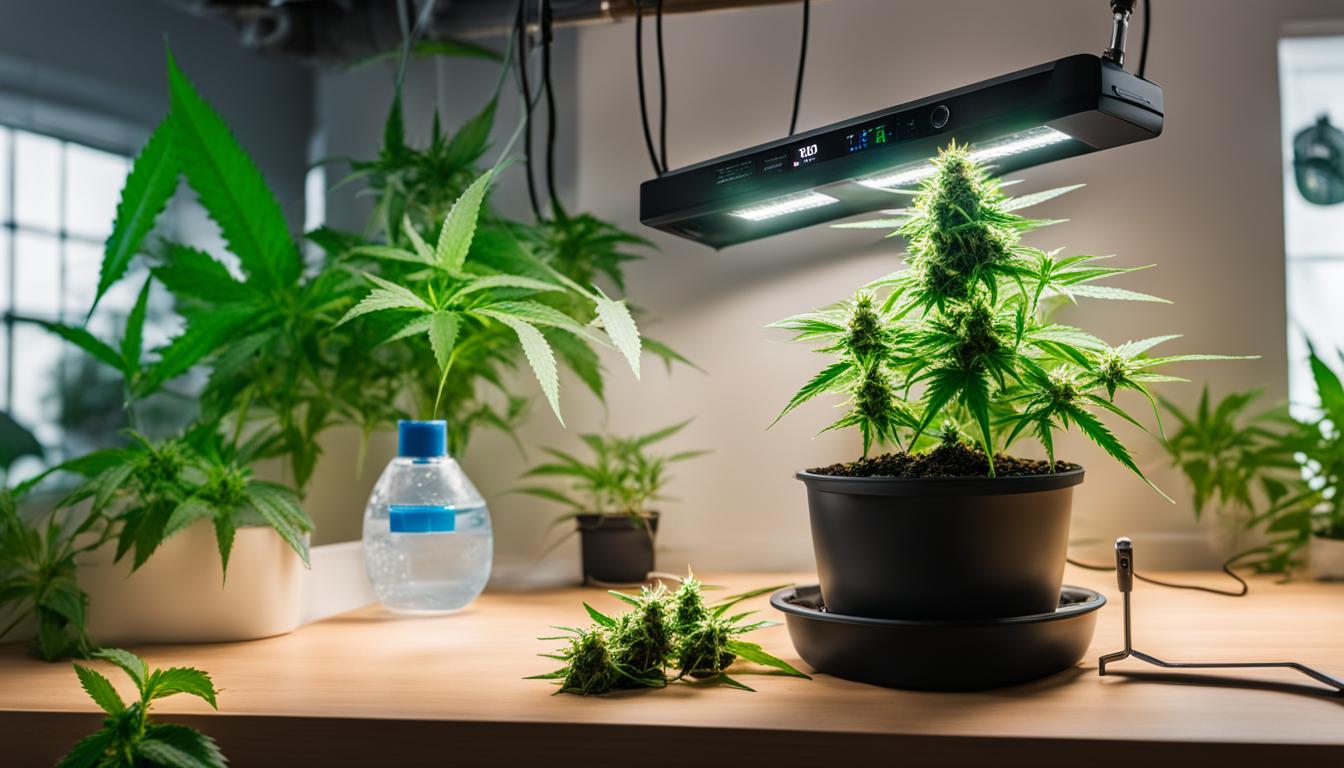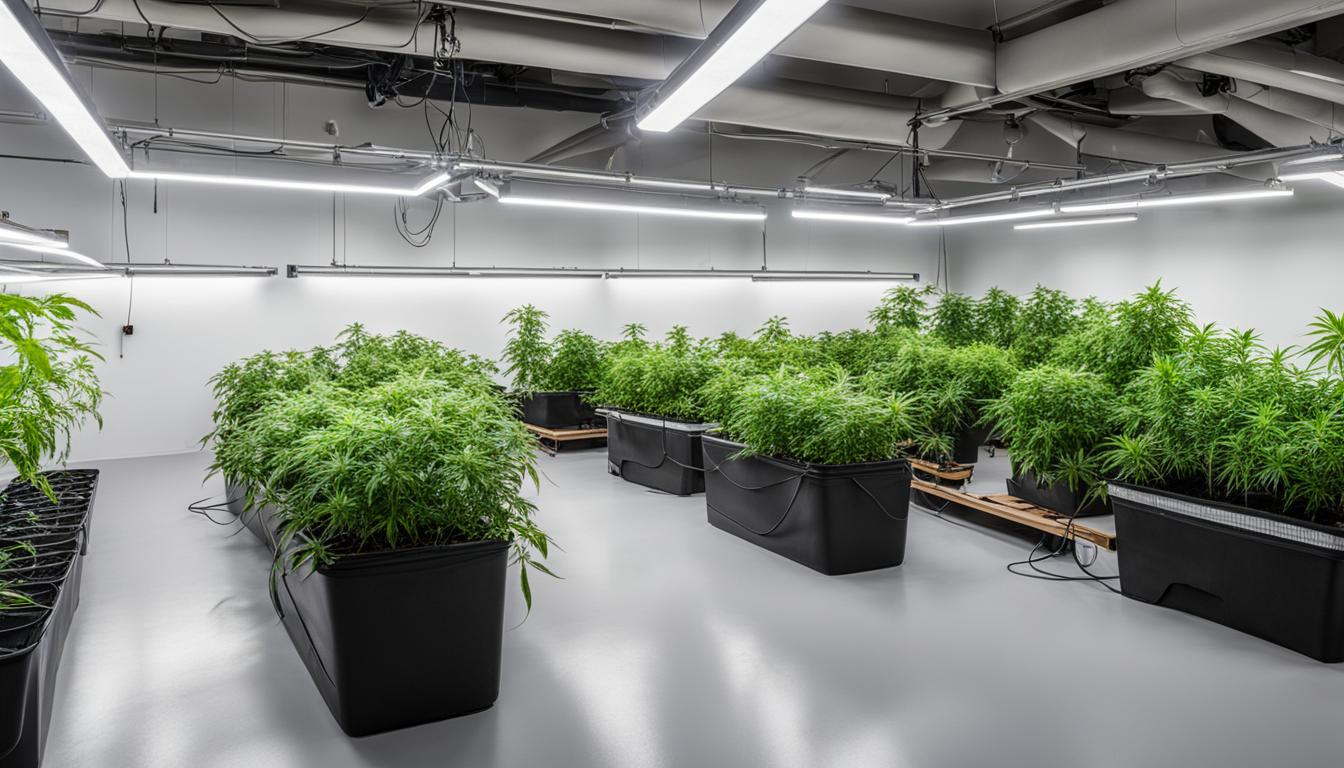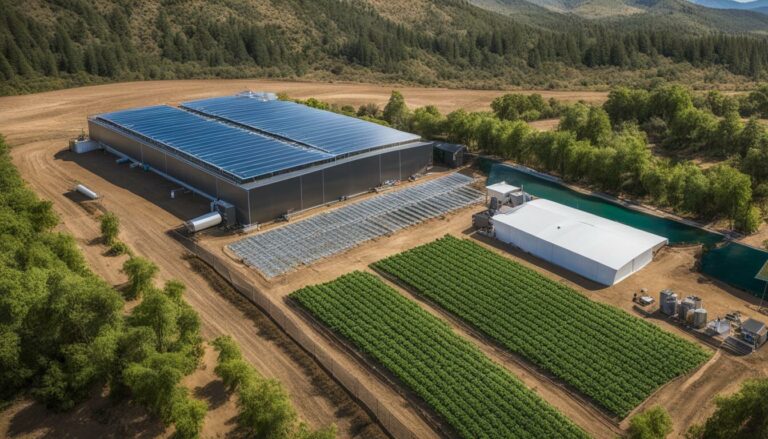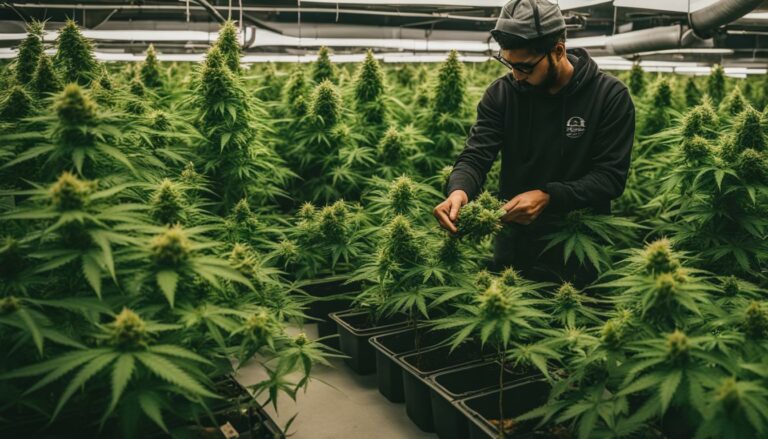The Role of Lighting in Cannabis Growth
Lighting is a crucial factor in the successful cultivation of cannabis. Whether you are growing indoors or in a greenhouse, the right lighting can make all the difference in the growth and development of your cannabis plants. In this article, we will explore the importance of cannabis lighting and how LED grow lights can help you achieve optimal results.
When it comes to indoor grow lights, LED technology has revolutionized the cannabis cultivation industry. These lights provide a spectrum of light that closely mimics natural sunlight, allowing you to create the perfect growing environment for your plants. LED grow lights are not only energy-efficient but also offer better light penetration and coverage, resulting in healthier and more productive plants.
Indoor grow lights are particularly beneficial for cannabis cultivation as they allow growers to have complete control over the light exposure. This means you can adjust the light intensity, spectrum, and duration to suit the specific needs of your cannabis plants at each stage of their growth cycle.
Whether you are a seasoned cannabis grower or just starting out, understanding the role of lighting in cannabis growth is essential for maximizing your yield and ensuring the overall success of your cultivation efforts. In the following sections, we will delve deeper into the importance of light in germination and photosynthesis, the impact of light on growth and development, and how to optimize light for enhanced crop productivity.
The Importance of Light in Germination and Photosynthesis
The role of light in cannabis cultivation extends beyond providing illumination; it plays a vital role in the process of germination and photosynthesis. During the germination stage, light exposure influences the growth and development of cannabis seeds. While some seeds require light to germinate, others need darkness. In greenhouse cultivation, growers have the flexibility to monitor and adjust light exposure to optimize seed germination.
Photosynthesis, the process through which plants convert light energy into chemical energy, is also heavily dependent on light. Without adequate light, plants cannot carry out photosynthesis, stunting their growth and development. Light acts as a catalyst for the production of glucose, which serves as food for the plant. It fuels the synthesis of chlorophyll, the green pigment essential for photosynthesis.
Table: Light Exposure and Germination
| Light Exposure | Germination Effect |
|---|---|
| Light | Stimulates germination in light-dependent seeds |
| Darkness | Encourages germination in light-independent seeds |
“Light exposure is crucial for cannabis seed germination. By ensuring the right amount of light or darkness, growers can optimize the germination process and set their plants up for success.”
Table: Photosynthesis and Light
| Light Intensity | Photosynthesis Effect |
|---|---|
| Adequate Light | Promotes optimal photosynthesis and plant growth |
| Inadequate Light | Stunts photosynthesis, leading to weak plant growth |
By understanding the importance of light in germination and photosynthesis, cannabis growers can harness its power. Through careful monitoring and adjustment of light exposure, growers can optimize seed germination and facilitate the production of glucose through photosynthesis. This ultimately leads to healthier and more resilient cannabis plants, setting the stage for a successful cultivation journey.
The Impact of Light on Growth and Development
In greenhouse cultivation, the quality and quantity of light that cannabis plants receive have a significant impact on their overall health and growth. The right balance of light is crucial for promoting healthy development and ensuring optimal growth. Insufficient light can lead to weakened stems, while excessive light can damage the plant, causing leaves and stems to become dry and brittle. Therefore, finding the optimal light levels for cannabis plants is essential to achieving successful cultivation.
The Role of Light Intensity
Light intensity plays a vital role in cannabis growth and development. It directly affects the rate of photosynthesis, which is the process that allows plants to convert light energy into chemical energy for growth and development. By monitoring and adjusting light intensity, growers can ensure that plants receive the right amount of light to carry out photosynthesis efficiently. This not only promotes healthy growth but also increases crop productivity and yield. Therefore, optimizing light intensity is crucial for maximizing the potential of greenhouse cultivation.
The Importance of Proper Light Distribution
Proper light distribution is another key factor in cannabis cultivation. Ensuring that light is evenly distributed throughout the greenhouse helps promote uniform growth and prevents shading. By considering factors such as height, angle, and distance, growers can optimize light distribution and create an ideal growing environment for cannabis plants. This allows each plant to receive adequate light exposure, resulting in consistent and healthy growth.
The Role of Light Spectrum
The spectrum of light that cannabis plants receive also impacts their growth and development. Different colors of light within the spectrum have specific effects on plant physiology. For instance, blue light stimulates vegetative growth and the production of leaves, while red light is crucial during the flowering stage, enhancing yield and cannabinoid production. By manipulating the light spectrum and providing the right balance of colors, growers can optimize plant growth and quality throughout different stages of cultivation.
| Light Factor | Impact on Cannabis Growth |
|---|---|
| Light Intensity | Directly affects photosynthesis and overall plant health |
| Light Distribution | Promotes uniform growth and prevents shading |
| Light Spectrum | Optimizes growth and development at different stages |
By understanding and optimizing these factors, cannabis growers can create an ideal lighting environment for their plants, ensuring optimal growth and development. Greenhouse cultivation provides the flexibility to monitor and adjust light levels, allowing growers to tailor light exposure to the specific needs of cannabis plants. With the right combination of light intensity, distribution, and spectrum, growers can maximize crop productivity and achieve consistent, high-quality yields.
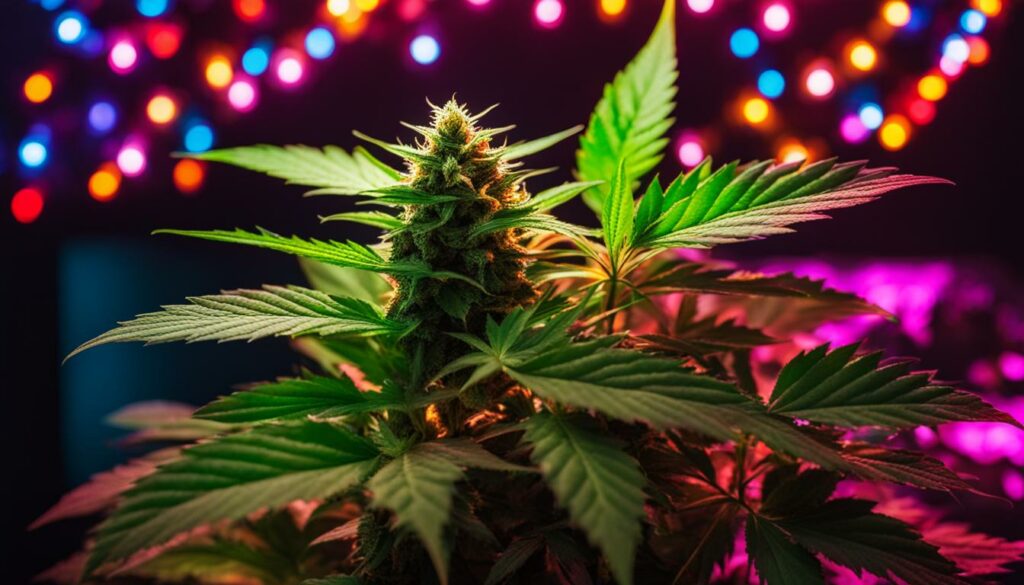
Optimizing Light for Enhanced Crop Productivity
Supplemental lighting, proper light distribution, light intensity, and light spectrum manipulation are key factors in optimizing cannabis growth and maximizing crop productivity. By implementing these strategies, growers can fine-tune their cultivation environments and provide the ideal conditions for their plants to thrive.
Supplemental Lighting
Supplemental lighting plays a crucial role in cannabis cultivation, especially in areas with limited natural sunlight or during the winter months when daylight hours are shorter. By providing additional light when natural light is insufficient, growers can ensure consistent and optimal light exposure for their plants. Supplemental lighting can be achieved through the use of artificial grow lights, such as LED or high-intensity discharge (HID) lights. These lights can be strategically placed to supplement natural sunlight and provide the necessary light intensity and spectrum for robust plant growth.
Light Distribution
Proper light distribution is essential for uniform growth and avoiding shading in cannabis crops. Factors such as the height, angle, and distance of the light source from the plants can significantly impact light distribution. Growers should aim to evenly distribute light throughout the cultivation area, ensuring that all plants receive equal exposure to promote consistent growth. This can be achieved by using reflective materials, such as reflective grow tents or walls, to maximize light reflection and prevent light loss. Regular monitoring and adjustment of light distribution can help maintain optimal conditions for cannabis plants.
Light Intensity and Spectrum Manipulation
Monitoring and controlling light intensity are crucial for ensuring optimal growth at each stage of the cannabis plant’s life cycle. Light intensity refers to the amount of light energy received by the plants and can be adjusted by manipulating the distance between the light source and the plants or by dimming the artificial lights. By finding the optimal light intensity for each growth stage, growers can promote healthy development and maximize crop yield.
Furthermore, manipulating the light spectrum by using different colors of light can have a productive effect on cannabis cultivation. Red and blue light, for example, are commonly used during the vegetative stage to promote vigorous growth, while a combination of red and far-red light is often employed during the flowering stage to enhance bud development. Light spectrum customization allows growers to fine-tune their lighting systems to meet the specific needs of different cannabis strains and optimize crop productivity.
By optimizing supplemental lighting, light distribution, light intensity, and light spectrum manipulation, cannabis growers can create the ideal growing conditions for their plants. These strategies enable them to control and tailor the light exposure to meet the specific requirements of their cannabis crops, resulting in enhanced growth, higher yields, and superior quality.
Risks of Cannabis Cultivation and the Importance of Insurance
Cannabis cultivation is not without its risks. Growers face numerous challenges that can have a detrimental impact on their crops, leading to significant financial losses. Unpredictable weather conditions, including extreme temperatures, storms, and droughts, pose a threat to the health and survival of cannabis plants. In addition, pests and diseases can quickly spread in a cultivation environment, putting the entire crop at risk.
Table: Risks in Cannabis Cultivation
| Risks | Impact |
|---|---|
| Extreme weather conditions | Potential damage or destruction of crops |
| Pests and diseases | Spread can lead to reduced yield or total loss |
| Irrigation system failures | Inadequate water supply, affecting plant health |
| Arson | Potential destruction of crops and property |
Given the potential risks and their impact, it is essential for cannabis growers to secure comprehensive insurance coverage. Cannabis insurance provides protection against unforeseen disasters, mitigating the financial burden on growers in the event of crop damage or loss. A comprehensive insurance policy can cover a range of risks, such as crop destruction due to extreme weather conditions, pest infestations, equipment failures, and even arson.
By obtaining cannabis insurance, growers can safeguard their investments and ensure the long-term stability of their cultivation businesses. Insurance coverage not only provides financial protection but also offers peace of mind, allowing growers to focus on cultivating high-quality cannabis without the constant worry of potential crop losses or damages.
The Influence of Light Spectrum on Cannabis Growth
Light spectrum plays a crucial role in the growth and development of cannabis plants. Different colors of light within the spectrum have varying effects on plant growth and can be manipulated to maximize crop productivity and quality. Understanding the impact of light spectrum is essential for cannabis growers seeking to achieve optimal results.
Blue Light: Promoting Vegetative Growth and Leaf Production
Blue light, with a wavelength of approximately 400 to 500 nm, is crucial during the vegetative phase of cannabis growth. It stimulates vegetative growth and the production of leaves, resulting in bushier and more robust plants. By providing the right amount of blue light during this stage, growers can encourage vigorous growth and create a strong foundation for the flowering phase.
Green Light: Regulating Plant Architecture and Photosynthesis
Although green light has minimal direct influence on plant growth, it plays a significant role in regulating plant architecture and photosynthesis. Green light, with a wavelength of approximately 500 to 570 nm, helps plants maintain proper spacing between leaves and optimize light distribution within the canopy. It also contributes to photosynthesis by enhancing chlorophyll synthesis and increasing overall photosynthetic efficiency.
Red Light: Enhancing Flowering and Cannabinoid Production
Red light, with a wavelength of approximately 620 to 740 nm, is essential during the flowering and budding stages of cannabis growth. It triggers the flowering response, promoting the development of flowers, and enhancing yield. Additionally, red light stimulates the production of cannabinoids, such as THC and CBD, which are responsible for the medicinal and psychoactive properties of cannabis. By providing adequate red light during flowering, growers can maximize both yield and cannabinoid content.
| Light Spectrum | Effect | Wavelength (nm) |
|---|---|---|
| Blue Light | Promotes vegetative growth and leaf production | 400-500 |
| Green Light | Regulates plant architecture and enhances photosynthesis | 500-570 |
| Red Light | Enhances flowering and stimulates cannabinoid production | 620-740 |
While blue, green, and red light are the primary colors that impact cannabis growth, other parts of the spectrum, such as UV light, can also play a role. UV light, with a wavelength of approximately 280 to 400 nm, has been found to increase terpene production, which contributes to the flavor and fragrance of cannabis strains. However, UV light should be used with caution, as excessive exposure can be damaging to plants.
By understanding the influence of light spectrum on cannabis growth and carefully manipulating the light colors during different growth stages, growers can optimize plant development, maximize yield, and enhance the quality of their cannabis crops.
The Best Grow Light Spectrum for Cannabis Cultivation
Choosing the right grow light spectrum is crucial for maximizing cannabis growth and yield. Different stages of the cannabis growth cycle require specific light spectrums to optimize plant development and flower production. Blue light and red light are two key spectrums that play significant roles in cannabis cultivation.
Blue Light Spectrum:
During the vegetative phase, cannabis plants benefit from a higher proportion of blue light. Blue light, with wavelengths between 400 and 500 nm, stimulates vegetative growth, promotes leaf development, and enhances overall plant structure. It is essential for strong, healthy plants with robust green foliage.
Red Light Spectrum:
As cannabis enters the flowering stage, the emphasis shifts towards red light. Red light, between 620 and 740 nm, encourages flowering and bud development. It stimulates the production of essential oils, cannabinoids, and terpenes, resulting in higher yields and improved potency. Red light also helps regulate plant metabolism, enhancing the plant’s ability to efficiently convert nutrients into energy.
While blue and red light are crucial, it is important to note that a balance of different light spectrums throughout the growth cycle is essential for optimal results. Full spectrum grow lights, which incorporate a range of wavelengths including blue and red, provide a comprehensive lighting solution for cannabis cultivation. These lights mimic natural sunlight, allowing for the full expression of plant genes and promoting healthy, vigorous growth from seed to harvest.
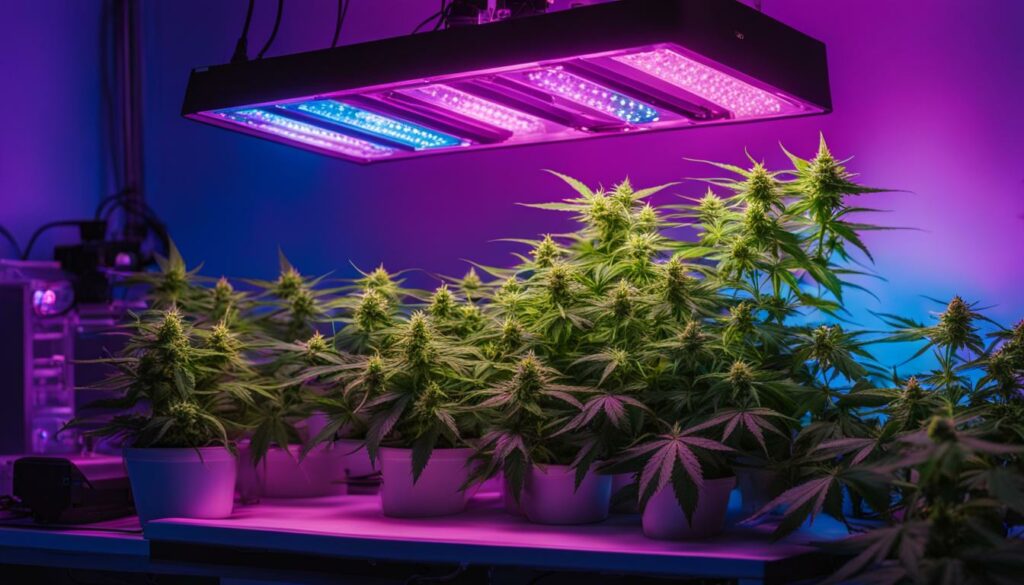
By carefully selecting a grow light spectrum that includes blue and red light and using full spectrum grow lights, cannabis growers can ensure their plants receive the ideal lighting conditions for each growth stage. This strategic approach to lighting optimization can lead to higher crop yields, improved cannabinoid and terpene profiles, and overall cultivation success.
| Growth Stage | Recommended Spectrum |
|---|---|
| Vegetative | Higher proportion of blue light (400-500 nm) |
| Flowering | Higher proportion of red light (620-740 nm) |
| Full Growth Cycle | Balance of blue, red, and other spectrums in full spectrum grow lights |
The Impact of Light Quality on Phytochemical Content in Cannabis
Light quality plays a crucial role in influencing the phytochemical content of cannabis, including cannabinoids and terpenes. By manipulating the light spectrum through the use of LED grow lights, growers can enhance the production of these valuable compounds. Customized light spectrums, combined with efficient dimming capabilities, allow for the fine-tuning of light settings to maximize phytochemical content.
Optimal levels of blue, green, and red wavelengths stimulate the synthesis of cannabinoids, such as THC and CBD, while the inclusion of white light enhances terpene production. These phytochemicals are responsible for the unique characteristics and medicinal properties of cannabis strains. By carefully controlling the light spectrum, growers can cultivate cannabis with desired cannabinoid and terpene profiles, catering to specific consumer preferences.
It is important to note that different strains may require specific light spectrums to maximize phytochemical content. Through research and experimentation, growers can determine the ideal light settings for each strain, ensuring consistent and optimal results. LED grow lights offer the flexibility and precision needed to customize the light spectrum, giving growers the power to unlock the full potential of their cannabis crops.
| Phytochemical | Light Spectrum | Role |
|---|---|---|
| Cannabinoids | Optimal levels of blue, green, and red wavelengths | Stimulates cannabinoid synthesis |
| Terpenes | Inclusion of white light | Enhances terpene production |
By harnessing the transformative power of LED grow lights and understanding the influence of light quality on phytochemical content, cannabis growers can cultivate high-quality strains with exceptional cannabinoid and terpene profiles. The ability to tailor the light spectrum to each strain’s specific needs opens doors to a world of possibilities in cannabis cultivation, where every detail can be fine-tuned to achieve excellence.

Partnering with Light Science Experts for Cannabis Cultivation
The success of a cannabis cultivation operation heavily relies on the understanding and implementation of effective lighting strategies. To achieve optimal cannabis yield and quality, it is essential for growers to partner with light science experts who have in-depth knowledge of cannabis lighting and can provide tailored solutions.
Light science experts specialize in the intricate relationship between light and plant growth, including the specific light spectrum requirements for cannabis cultivation. By working with these professionals, growers can benefit from their expertise in developing LED grow lights with customized spectra that are optimized for maximizing yield and phytochemical content.
Expertly designed LED grow lights offer several advantages for cannabis cultivation. They provide a precise and controllable light spectrum, allowing growers to customize the lighting conditions to meet the unique needs of different cannabis strains and growth stages. This level of customization ensures that plants receive the right light wavelengths at the right intensity and duration, promoting healthy growth and optimal cannabinoid and terpene production.
Furthermore, partnering with reputable light science companies ensures ongoing support and guidance throughout the cultivation process. These companies offer valuable insights, technical assistance, and access to innovative lighting technologies that can significantly enhance cultivation success. By availing themselves of the expertise and resources provided by light science experts, cannabis growers can optimize their lighting strategies and achieve consistent, high-quality yields.
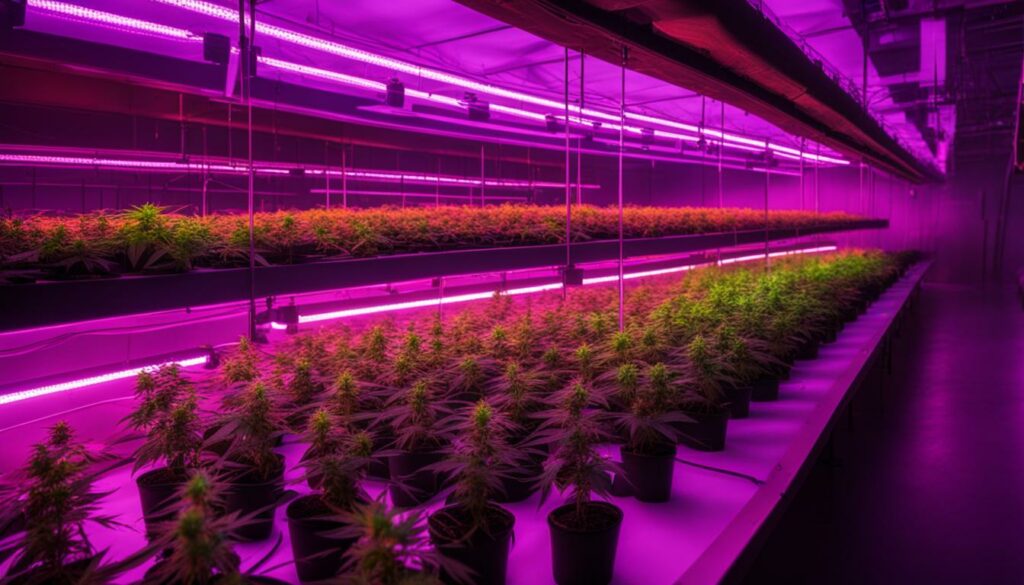
Benefits of Partnering with Light Science Experts
Working with light science experts for cannabis cultivation offers the following benefits:
- Access to tailored lighting solutions with optimized spectra for cannabis yield and quality.
- Expert guidance in implementing optimal lighting strategies for different growth stages.
- Technical support and ongoing assistance throughout the cultivation process.
- Enhanced control over light spectrum, intensity, and duration for optimal plant growth.
- Opportunity to leverage innovative lighting technologies for superior results.
The Importance of Comprehensive Cannabis Insurance
As cannabis cultivation continues to expand, growers face unique challenges and risks that can jeopardize their business. From unpredictable weather conditions to pests and diseases, there are many factors that can threaten the success of a cannabis crop. That’s why comprehensive cannabis insurance is crucial for protecting against these unforeseen disasters and ensuring the long-term safety and stability of the cannabis industry.
Cannabis insurance provides coverage for a wide range of risks that growers may encounter. This can include crop protection against natural disasters such as storms, floods, and wildfires. It can also cover damage caused by pests, diseases, and even theft or vandalism. By obtaining proper insurance coverage, growers can have peace of mind knowing that their investment is protected.
Greenhouse insurance is especially important for cannabis cultivators who rely on controlled environments to grow their crops. Greenhouses are susceptible to various risks, including structural damage, equipment failure, and power outages. With the right insurance coverage, growers can mitigate these risks and ensure that their operations can continue uninterrupted, even in the face of adversity.
Choosing the right insurance provider is crucial for cannabis growers. It’s important to work with an insurance company that specializes in cannabis coverage and understands the unique needs and risks of the industry. By partnering with a reputable insurer, growers can access tailored insurance policies that provide comprehensive coverage and address the specific risks they face.
| Benefits of Comprehensive Cannabis Insurance |
|---|
| Protection against crop loss due to natural disasters |
| Coverage for damage caused by pests and diseases |
| Financial compensation for theft or vandalism |
| Protection against structural damage and equipment failure |
| Continuity of operations in the event of power outages |
Comprehensive cannabis insurance is not just a safety net, but a critical tool for cultivators to protect their investment and ensure the long-term success of their business. By understanding the importance of insurance and partnering with the right insurance provider, cannabis growers can navigate the risks of cultivation with confidence.
The Transformative Power of Cannabis Lighting
Proper lighting plays a pivotal role in the success of cannabis cultivation. With the advent of LED grow lights, indoor growers now have the ability to harness the transformative power of light to optimize plant growth and enhance crop productivity. By implementing smart lighting strategies, cannabis growers can unlock the full potential of their plants and achieve remarkable cultivation success.
LED grow lights have revolutionized the way cannabis is grown indoors. These lights provide the ideal spectrum of light that cannabis plants require for each growth stage, from germination to flowering. By tailoring the light spectrum to meet the specific needs of the plants, growers can promote healthy development, increase yields, and maximize the quality of the final product.
Furthermore, LED grow lights offer energy efficiency and longevity, making them a cost-effective choice for indoor cannabis cultivation. With the ability to fine-tune light intensity and manipulate the light spectrum, growers have precise control over the growth environment, allowing them to create optimal conditions for their plants. Whether it’s adjusting the blue light for vegetative growth or adding red light during flowering, these lights provide unparalleled flexibility and customization.
The transformative power of cannabis lighting cannot be underestimated. By harnessing the full potential of LED grow lights and implementing smart lighting strategies, cannabis growers can illuminate their cultivation journey, achieving superior yields, consistent quality, and a flourishing business.
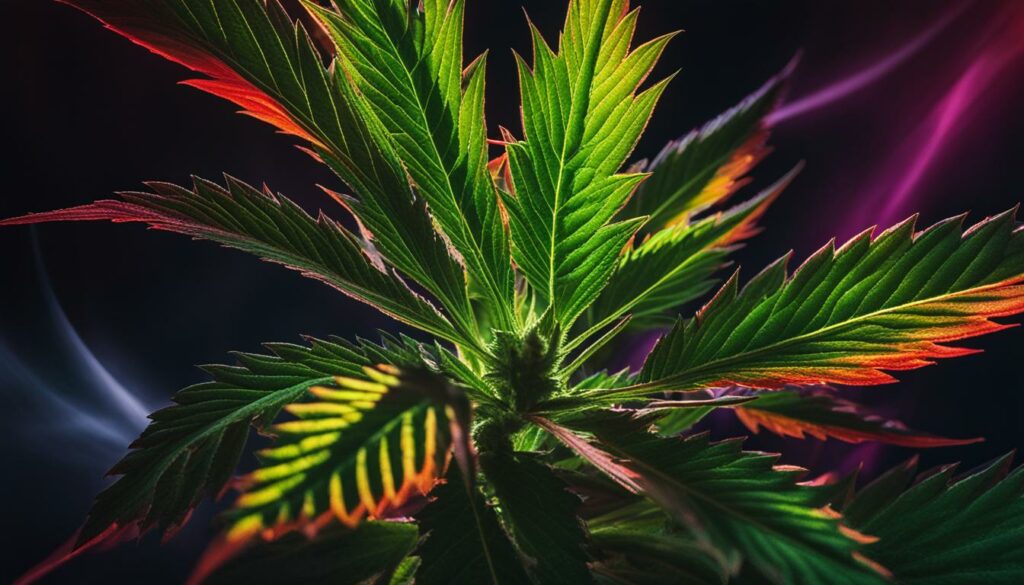
Table: Benefits of LED Grow Lights for Cannabis Cultivation
| Benefit | Description |
|---|---|
| Optimized Spectrum | LED grow lights provide the ideal spectrum of light for each growth stage, promoting healthy development and maximizing yields. |
| Precise Control | Growers can fine-tune light intensity and manipulate the light spectrum, creating optimal conditions for their plants and maximizing growth potential. |
| Energy Efficiency | LED grow lights consume less energy compared to traditional lighting methods, resulting in significant cost savings. |
| Longevity | LED grow lights have a longer lifespan, reducing the need for frequent replacements and providing greater value for money. |
| Customization | With adjustable light settings, growers can tailor the lighting environment to suit the specific needs of different cannabis strains. |
“LED grow lights have completely transformed the way we cultivate cannabis indoors. The ability to provide the precise spectrum of light throughout the growth cycle has revolutionized our yields and quality. It’s like giving our plants the perfect recipe for success.” – Experienced cannabis grower
Related Articles
- How Does Lighting Spectrum Affect Cannabis Growth and Yield?
- What Are the Best Lighting Solutions for Small Scale Cannabis Grows?
- How to Calculate the Right Amount of Light for Your Cannabis Plants?
- LED vs. HID Lights: Which is More Efficient for Cannabis Cultivation?
- How to Optimize Light Cycles for Maximum Cannabis Growth?
Conclusion
Cannabis cultivation thrives on the art of harnessing the power of light. By understanding the crucial role that light plays in different stages of growth, growers can unlock the full potential of their crops. The right lighting techniques and strategies, combined with the use of tailored grow light spectrums, are the keys to achieving optimal crop productivity and superior quality.
Partnering with experts in light science can further elevate cultivation success. These professionals possess the knowledge and expertise to develop LED grow lights with customized spectrums that maximize yields and enhance phytochemical content. With their guidance, cannabis growers can navigate the complex world of light and cultivate with confidence.
It is essential for growers to safeguard their investments through comprehensive cannabis insurance coverage. By protecting against unforeseen disasters and cultivation risks, they ensure the long-term safety and stability of their businesses. With proper insurance, growers can focus on nurturing their crops and pushing the boundaries of cannabis cultivation.
As cannabis cultivation continues to evolve, the importance of lighting and crop protection cannot be overstated. With a deep understanding of the role of light, the right resources, and a commitment to excellence, growers can illuminate their way to thriving cultivation businesses and contribute to the ever-growing world of cannabis.
FAQ
What is the role of lighting in cannabis growth?
Lighting plays a crucial role in greenhouse cannabis cultivation, influencing plant growth, germination, photosynthesis, and overall development.
How does light affect germination and photosynthesis in cannabis?
Light is vital during the germination stage, affecting the growth and development of cannabis seeds. Additionally, light is essential for photosynthesis, the process through which plants convert light energy into chemical energy, enabling them to produce their own food.
How does light impact the growth and development of cannabis plants?
The quality and quantity of light significantly affect the overall health and growth of cannabis plants. Inadequate light can result in weakened stems, while excessive light can damage the plant. Optimal light levels are crucial for promoting healthy development.
How can growers optimize light for enhanced crop productivity?
Growers can optimize the effect of light through various strategies, such as using supplemental lighting, ensuring optimal light distribution, monitoring light intensity, and manipulating the light spectrum.
Why is cannabis insurance important for growers?
Cannabis growers face various risks, including extreme weather conditions, diseases, and even arson. Comprehensive cannabis insurance coverage helps lower cultivation risks and provides financial protection in case of unforeseen disasters.
What is the influence of light spectrum on cannabis growth?
Different colors of light within the spectrum have varying effects on cannabis growth. Blue light promotes vegetative growth, green light helps regulate plant architecture, red light enhances flowering and budding stages, and UV light enhances terpene production.
How can growers choose the best grow light spectrum for cannabis?
The cannabis growth cycle consists of germination, seedling, vegetative, and flowering stages. Each stage requires a specific light spectrum. Blue light is ideal for the vegetative phase, red light is beneficial for flowering, and a balance of blue, green, and red light is essential throughout the growth cycle.
How does light quality impact phytochemical content in cannabis?
Light quality manipulation through LED grow lights can enhance the phytochemical content in cannabis flowers. Customized light spectrums, combined with efficient dimming capabilities, can increase cannabinoid and terpene production.
Why should cannabis growers partner with light science experts?
Working with experienced light science professionals can greatly benefit cannabis growers. These experts understand the intricate relationship between light and cannabis quality and can develop LED grow lights with tailored light spectrums for optimal yield and phytochemical content.
How important is comprehensive cannabis insurance for growers?
Cannabis growers face unique challenges and risks. Comprehensive cannabis insurance is crucial for protecting against unforeseen disasters that can lead to the destruction of the crop. Obtaining proper insurance coverage can help lower cultivation risks and provide financial protection, ensuring the long-term safety and stability of the cannabis business.
What is the transformative power of cannabis lighting?
Understanding the role of lighting in cannabis cultivation and implementing smart lighting strategies can have a transformative effect on plant growth and crop productivity. From optimizing light distribution to manipulating the light spectrum, utilizing the right grow lights and techniques can result in superior yields and consistent quality.
What is the importance of a conclusion?
A conclusion provides a summary of the main points discussed and reinforces the importance of cannabis lighting, grow light spectrum, and crop protection in cannabis cultivation.



